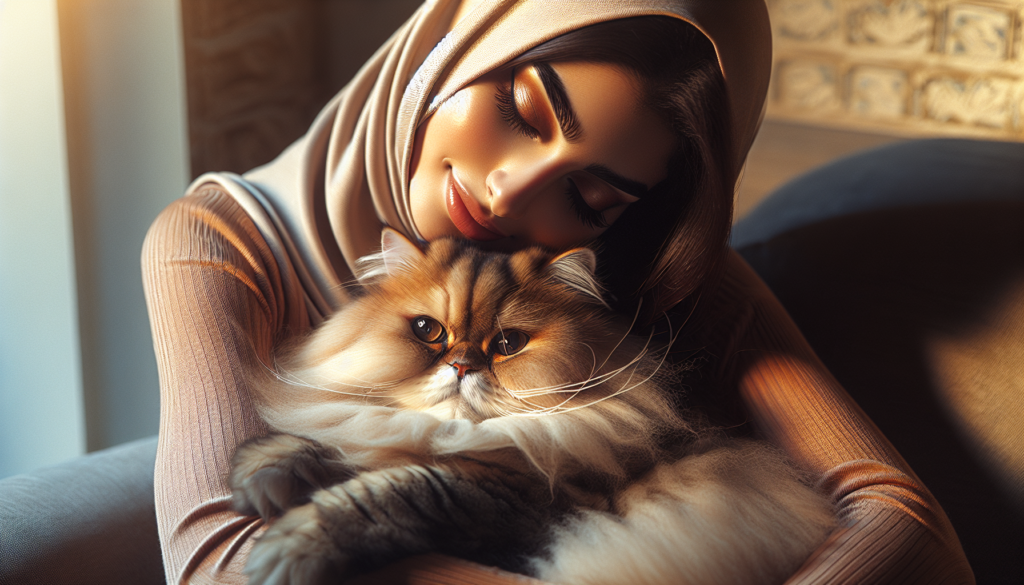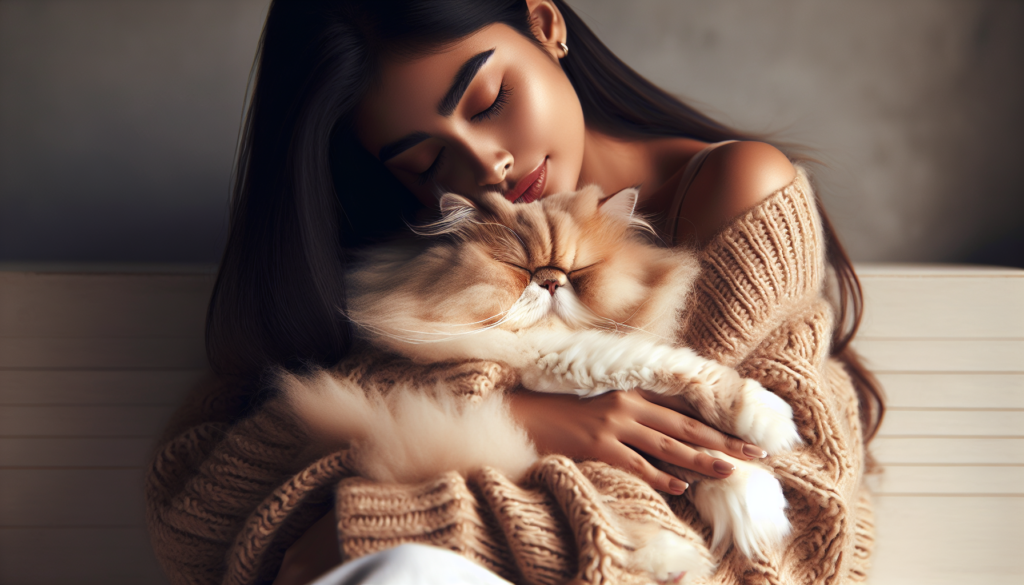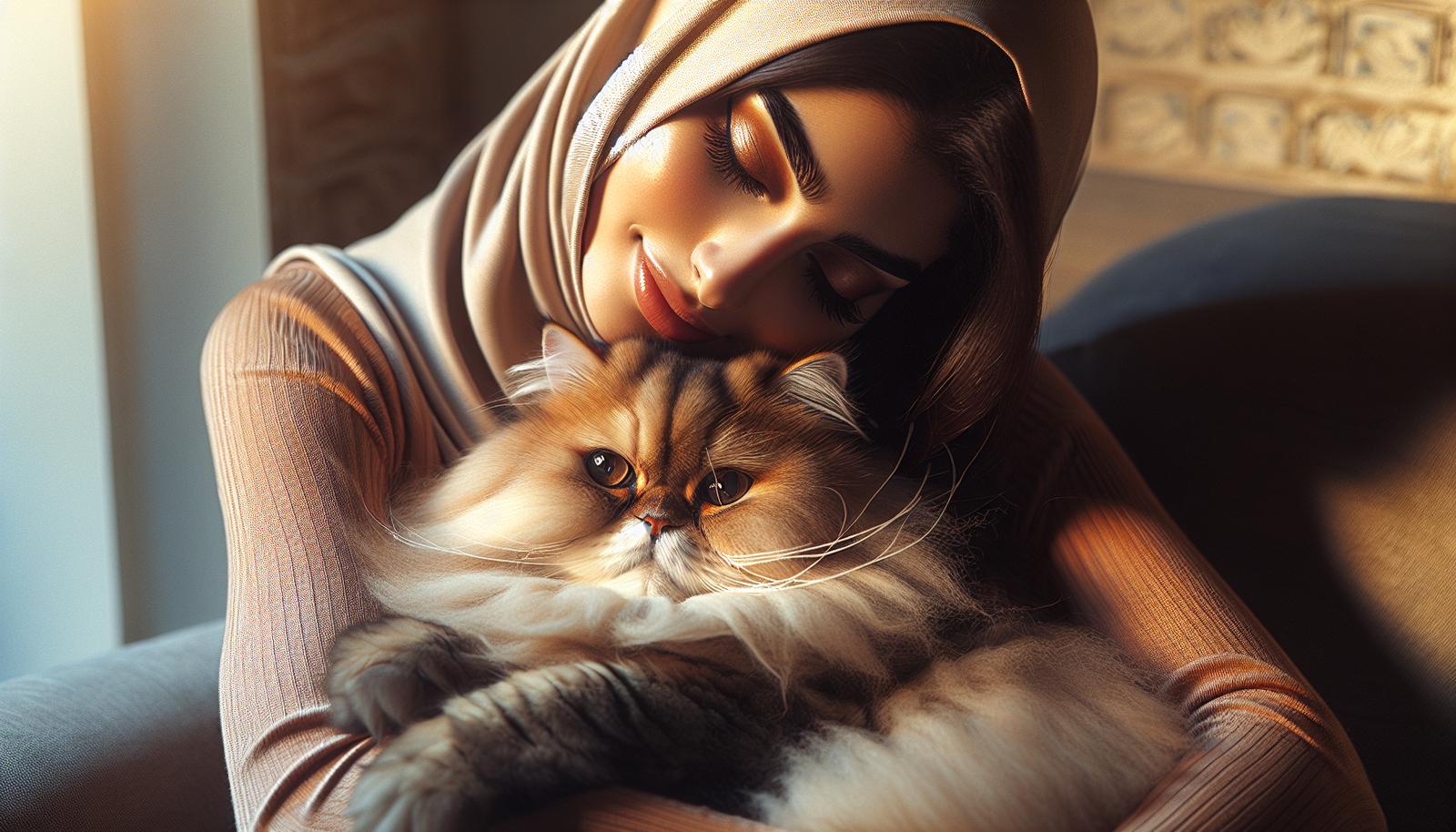If you’ve ever wondered whether Persian cats are the ultimate cuddling companions, then you’re in for a treat. This article takes a closer look at the personality of these adorable felines, exploring their affinity for affection and their unmistakable charm. Whether you already share your home with a Persian cat or are considering adding one to your family, get ready to uncover the answer to the age-old question: Do Persian cats enjoy cuddling?

Physical Characteristics of Persian Cats
Long and Fluffy Fur
One of the most distinguishable physical characteristics of Persian cats is their long and fluffy fur. Their luscious coats are known for their luxurious thickness and silky texture. The fur comes in various colors and patterns, adding to the overall charm of these feline beauties. It’s important to note that this long fur requires regular grooming and maintenance to prevent matting and keep it in optimal condition.
Large and Round Eyes
Another captivating feature of Persian cats is their large and round eyes. Their expressive eyes are usually set wide apart and give them a sweet, innocent look. The eye color can vary, but it commonly ranges from shades of blue, green, gold, or copper. Their eyes not only enhance their beauty but also play a crucial role in reflecting their emotions and connecting with their human companions.
Short Muzzle and Flat Face
Persian cats have a distinct facial structure characterized by a short muzzle and a flat face. This unique facial arrangement, known as brachycephalic, sets them apart from other cat breeds. The flat face contributes to their adorable appearance, but it can also present certain health concerns. The shortened airways in these cats may result in breathing difficulties and make them prone to overheating. Therefore, it’s important to provide them with appropriate care and ensure they have a comfortable environment.
Personality Traits of Persian Cats
Gentle and Calm
Persian cats are renowned for their gentle and calm nature. They possess a serene and composed demeanor that often brings a sense of tranquility to their surroundings. These cats tend to have a relaxed and laid-back temperament, making them ideal companions for people who value a peaceful and harmonious home environment.
Affectionate and Social
While Persian cats may have a reputation for being regal and independent, they also possess a deeply affectionate and social side. Once they form a bond with their human family, they can be incredibly loving and devoted. They enjoy being in the company of their loved ones and crave attention and companionship. Their affectionate nature often shines through in their interactions, as they eagerly seek out cuddles and snuggles.
Reserved and Independent
Despite their affectionate tendencies, Persian cats also have a slightly reserved and independent side. They value their personal space and may require some alone time to recharge. It’s essential to respect their need for solitude and not overwhelm them with constant attention. Understanding their independent nature will help establish a healthy balance between quality bonding time and giving them the space they desire.
Understanding Persian Cats’ Behavior
Preference for Quiet Environments
Persian cats are known to prefer quiet and peaceful surroundings. Loud noises and chaotic environments can cause them stress and anxiety. They thrive best in calm and stress-free settings, where they can relax and feel secure. If you have a Persian cat, it’s important to create an environment that minimizes disturbances and provides them with a peaceful haven to retreat to whenever needed.
Adaptability to Different People
While some cats may be more selective when it comes to forming bonds with individuals, Persian cats tend to be more adaptable and accepting of various people. They generally get along well with all family members, including children and other pets, as long as they are introduced gradually and with proper socialization. Their gentle and amicable nature allows them to adjust well to different personalities and temperaments.
Affinity for Routine
Persian cats are creatures of habit and often thrive in a structured and predictable routine. They appreciate consistency in their daily lives and may feel more secure when their environment follows a familiar pattern. Establishing a routine for feeding, playtime, grooming, and cuddling sessions can help them feel at ease and facilitate a stronger bond between you and your furry companion.
The Importance of Socialization
Early Socialization Training
Socialization plays a vital role in the development of Persian cats’ behavior and enables them to become well-adjusted and confident individuals. It is crucial to expose them to various experiences, people, and environments from an early age. Gradual and positive exposure to different stimuli helps them become more adaptable, friendly, and less prone to fear or aggression.
Positive Interactions with Humans
Persian cats thrive on positive interactions with their human companions. Ensuring that interactions are gentle, kind, and full of love is essential in building trust and strengthening your bond. Regular petting, grooming, and engaging play sessions can help them associate humans with pleasure and create a positive association with cuddling and physical contact.
Building Trust and Comfort
Trust is a fundamental aspect of any relationship, and it is no different when it comes to your Persian cat. Building trust takes time and patience. Allow your cat to approach you on their terms and never force physical contact or cuddling if they seem uncomfortable or apprehensive. Providing a safe and secure environment and demonstrating consistent love and care will go a long way in establishing a strong foundation of trust and comfort.

The Cuddling Behavior of Persian Cats
Individual Preferences
Just like humans, Persian cats have individual preferences and personalities when it comes to cuddling. While many Persian cats thoroughly enjoy cuddling, others may prefer shorter periods of physical contact or express their affection in other ways. It’s essential to observe and respect your cat’s unique preferences and adjust your cuddling sessions accordingly.
Affectionate Nature
Due to their gentle and affectionate nature, Persian cats often seek out opportunities for closeness and physical contact with their owners. They enjoy being stroked, petted, and held close. Cuddling not only provides them with warmth and comfort but also strengthens the emotional bond between you and your feline friend.
Enjoying Physical Contact
Persian cats typically find comfort in physical contact and enjoy being in close proximity to their human companions. They often exhibit contentment and relaxation when involved in cuddling sessions, purring softly and kneading their paws. The sensation of touch and the warmth of human contact can be incredibly soothing and reassuring for them.
Signs of Enjoyment and Discomfort
Purring and Kneading
Purring is often considered a sign of contentment and relaxation in cats. When a Persian cat purrs during a cuddling session, it indicates that they are enjoying the physical contact and feel safe and secure in your presence. Kneading, where they rhythmically push their paws against a surface, is another behavior often associated with pleasure and comfort.
Relaxed Body Language
A Persian cat’s body language can provide valuable insights into their level of comfort and enjoyment during cuddling. If they are relaxed and at ease, their body will appear loose and free of tension. Their tail may gently sway or curl comfortably, and their eyes will remain half-closed or softly focused. These relaxed indicators are a positive sign that they are enjoying the cuddling session.
Avoidance and Stress Signals
It’s essential to pay attention to any signs of discomfort or stress during cuddling. Persian cats may display subtle cues such as a stiff body, dilated pupils, or a flicking tail, indicating that they may prefer to end the cuddling session or need some space. It’s crucial to respect these boundaries and give them the freedom to retreat when they feel overwhelmed or uneasy.
Creating a Cuddle-Friendly Environment
Comfortable and Safe Spaces
Providing Persian cats with comfortable and safe spaces is essential for creating a cuddle-friendly environment. Ensure they have access to cozy beds or blankets where they can retreat and relax when they need some alone time. Designate a comfortable area in your home where you can engage in cuddling sessions without interruptions or disturbances.
Soft and Cozy Bedding
Persian cats appreciate soft and cozy bedding to snuggle into. Investing in high-quality, plush bedding will not only provide them with a comfortable space but also enhance their cuddling experience. Look for materials that are gentle on their sensitive skin and easy to clean to maintain optimal hygiene.
Encouraging Positive Associations
Associating cuddling with positive experiences can help create a cuddle-friendly environment. Combine cuddling sessions with other enjoyable activities such as gentle brushing, playtime, or offering treats. By pairing cuddling with pleasurable sensations, you can reinforce the positive association and increase their enthusiasm for cuddling.
Tips for Effective Cuddling Sessions
Letting the Cat Initiate
Persian cats, like many other felines, appreciate having control over their interactions. Allow your cat to initiate cuddling by approaching you or indicating their desire for physical contact. This ensures that they feel comfortable and are fully engaged in the cuddling session, leading to a more enjoyable and stress-free experience for both of you.
Being Gentle and Patient
Gentleness and patience are key when it comes to cuddling with Persian cats. Use soft, slow strokes and avoid making sudden movements or applying excessive pressure. Take the time to observe their reactions and respond accordingly. Some cats may need a few minutes to settle into the cuddling session, so be patient and understanding.
Respecting Boundaries
Just like humans, cats have boundaries when it comes to physical contact. Be respectful of your Persian cat’s signals and cues, and never force them to continue cuddling if they show signs of distress or discomfort. It’s important to honor their need for personal space and allow them to freely express their preferences.
Potential Challenges and Solutions
Allergic Reactions
Some individuals may experience allergic reactions to Persian cats’ fur or dander. If you or anyone in your household has allergies, it’s necessary to take precautions to minimize exposure. Regular grooming, frequent vacuuming, and creating designated cat-free zones in your home can help reduce allergens and make cuddling sessions more comfortable for everyone involved.
Resistance to Cuddling
While Persian cats are generally known for their affectionate nature, some cats may resist or show limited interest in cuddling. Every cat is unique, and their preferences can vary. If your Persian cat seems uninterested in cuddling, respect their boundaries and try to engage in other activities that they enjoy, such as interactive play or gentle brushing. Remember, not all cats are natural cuddlers, and that’s okay!
Overstimulation and Scratching
During cuddling sessions, it’s crucial to be mindful of your Persian cat’s boundaries and avoid overstimulation. Cats have sensitive areas that they may not enjoy being touched, such as their bellies or tails. If you notice signs of restlessness or agitation, it’s best to redirect their attention to a different activity or give them some space to prevent potential scratching or biting.
Conclusion
Persian cats possess a combination of physical characteristics and personality traits that make them both visually stunning and wonderful companions. Their long and fluffy fur, large round eyes, and unique facial structure are key physical features that contribute to their charm. Their gentle and calm nature, along with their affectionate and social tendencies, attracts many cat lovers to this breed.
Understanding Persian cats’ behavior, including their preference for quiet environments, adaptability to different people, and affinity for routine, helps create a nurturing and fulfilling life for these cats. Socialization, positive interactions, and building trust are crucial for fostering a strong bond between cat and owner.
When it comes to cuddling, Persian cats generally enjoy physical contact and being close to their human companions. However, it’s important to respect their individual preferences, observe signs of enjoyment or discomfort, and create a cuddle-friendly environment that promotes relaxation and trust.
By following tips for effective cuddling sessions, such as letting the cat initiate, being gentle and patient, and respecting boundaries, you can create a positive and enriching cuddling experience for both you and your Persian cat. Remember, every cat is unique, so it’s essential to tailor your approach to their specific needs and personality.
While there can be challenges, such as allergic reactions or resistance to cuddling, understanding and accommodating these concerns can help foster a stronger bond and ensure a harmonious relationship with your Persian cat.
In the end, knowing and appreciating the distinct characteristics and behaviors of Persian cats can help you better understand their preferences, provide adequate care, and create a loving environment where cuddling can be enjoyed by all. So go ahead, snuggle up with your furry friend, and cherish the warmth and affection that only a Persian cat can bring into your life.

